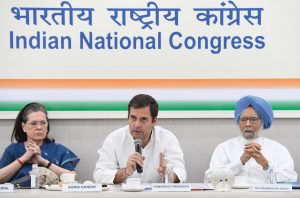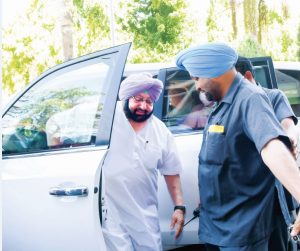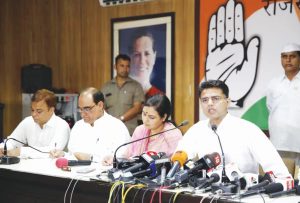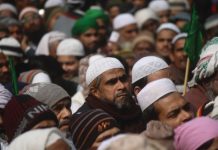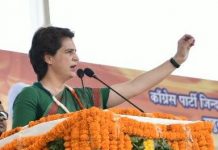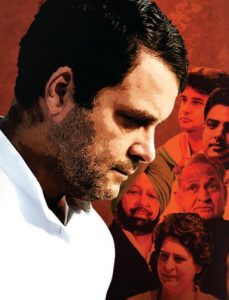 Congress President, Rahul Gandhi’s offer to resign from the post of party chief and refusing to take back resignation all these days, taking entire responsibility for the 2019 Lok Sabha poll rout, has evoked a sense of déjà vu. The reason this is a repeat of 2014 when Congress got its worst ever tally of 44 seats in Lok Sabha. This was a historic low for India’s grand old party and the fact that the Congress couldn’t even claim the post of the Leader of the Opposition as a party needs to win 10 per cent of Lok Sabha seats 55 to be precise to be able to claim the post of the Leader of the Opposition.
Congress President, Rahul Gandhi’s offer to resign from the post of party chief and refusing to take back resignation all these days, taking entire responsibility for the 2019 Lok Sabha poll rout, has evoked a sense of déjà vu. The reason this is a repeat of 2014 when Congress got its worst ever tally of 44 seats in Lok Sabha. This was a historic low for India’s grand old party and the fact that the Congress couldn’t even claim the post of the Leader of the Opposition as a party needs to win 10 per cent of Lok Sabha seats 55 to be precise to be able to claim the post of the Leader of the Opposition.
The party was 11 short of even this claim. In 2019, the party slightly improved its tally to 52 but was still short by three seats to claim the post of leader of opposition in Lok Sabha.
After 2014 results, the then Congress President, Sonia Gandhi had offered to resign from the post of party chief. The Congress Working Committee (CWC) had not only rejected the offer but also reposed faith in her leadership. However, she continued as party boss for some time till the baton was passed on to her son Rahul Gandhi who was seen as the challenger to Narendra Modi.
Why Rahul resigned?
Long seen as a reluctant politician, Rahul Gandhi began earning rave praise for being more mature, and not the reluctant prince of the yore. Of course, not many gave Rahul Gandhi a shot at the Prime Minister’s Office. But, many hoped that he could at least script a turnaround for the Congress. However, it was only a wishful thinking as in the 2019 Lok Sabha election, the Congress improved on its 2014 tally by just eight seats, winning 52 Lok Sabha seats. This time as well, the party will not be able to claim the post of the Leader of the Opposition. What hurt Rahul Gandhi most was that he lost the Congress stronghold of Amethi to Smriti Irani. Perhaps that explains Rahul Gandhi’s reported desire to quit as party president.
A pall of gloom hangs heavy over 24 Akbar Road, Delhi. Rahul Gandhi continues to be adamant and has refused to withdraw his resignation from the post of Congress president. In the wake of Bharatiya Janata Party’s massive Lok Sabha 2019 victory, the Congress seems adrift, rudderless, totally at sea. The chest-beating among Congress courtiers collected at the party headquarters has not stopped since May 25 when Rahul Gandhi had made the surprise announcement.
What was different this time was Rahul’s tough talk as he targeted certain senior leaders for putting the interests of their sons ahead of the interest of the party. In his line of fire were Chief Ministers Ashok Gehlot and Kamal Nath and former Finance Minister P Chidambaram.
Rahul Gandhi immediately refused to accept the suggestion that Priyanka Gandhi Vadra could take over the presidentship of the party and reportedly shot back at the AICC meeting “why only from Gandhi family”. In fact, taking an uncompromising stand, Rahul also asked the CWC to choose a new leader from outside the Gandhi family. However, the proposal was unanimously turned down.
Rahul Gandhi has refused to budge from his stand in the aftermath of Congress poor performance and saffron surge across the country. It all began with party president Rahul Gandhi accepting responsibility for the defeat and pointing out that the Congress had done badly in states where it was in power like Rajasthan and Madhya Pradesh. The blame game shows no signs of ebbing with Rajasthan CM Ashok Gehlot blaming his deputy Sachin Pilot for son Vaibhav’s defeat in the Lok Sabha polls. The escalation shows the party president’s observation has gone unheeded even as Gehlot’s son trailed in the Assembly segment represented by his father.
Even in Punjab, where Congress has done well under Capt Amarinder Singh, the blame game continues with the minister, Navjot Singh Sidhu criticizing the chief minister for losses in Bathinda and Ferozepur where Shiromani Akali Dal nominees, Harsimrat Kaur Badal, and Sukhbir Singh Badal clinching victories. Capt Amarinder Singh has acted against Sidhu by divesting him of Local Bodies Ministry charge alleging that vote share in urban areas had shrunk. Not to be cowed down, Sidhu met Rahul Gandhi and Priyanka Gandhi and his pictures appeared in media, showing a defiant Sidhu. Congress general secretary Priyanka Gandhi Vadra and party treasurer Ahmed Patel were present when Sidhu called on the Congress chief. This was the first time Gandhi had met a party leader at his house after the May 25 meeting of the Congress Working Committee (CWC), where he announced his decision to step down.
Sidhu tweeted “Met the Congress President, handed him my letter, appraised him of the situation !” Sidhu tweeted with a photo of Gandhi, Priyanka, and senior leader Ahmed Patel. In Haryana, knives are out for state party chief Ashok Tanwar with former Chief Minister Bhupinder Singh Hooda seeking changes. In Punjab, there is demand for action against the Local Bodies Minister Navjot Singh Sidhu for his ‘friendly’ match comment against Capt Amarinder Singh and the latter alleging that Sidhu was eyeing the CM’s chair. In Maharashtra, senior party leader Radhakrishna Vikhe Patil has hinted at joining the BJP and the Karnataka state unit has drawn flak for sidelining seniors.
Earlier, spokesperson Priyanka Chaturvedi left her party to join the Shiv Sena. Since there is no clarity on the party president Rahul Gandhi and even party spokespersons have been told to not to give media briefing for some time, nothing can be said about changes in the state units with certainty. Rahul Gandhi and his future, both as a politician and as the president of Congress party, is uncertain. All eyes, now, are on India’s grand old party, the Congress and its president, Rahul Gandhi.
Now the ball is in Rahul’s court. However, what is adding fuel to fire are media reports that Rahul Gandhi is adamant on resigning. Fresh reports suggested that Rahul Gandhi has already delivered an ultimatum to long-time Gandhi family confidant Ahmed Patel. Gandhi, reportedly, asked Patel to find a replacement as he was firm on his decision to step down as Congress chief. So, will Rahul Gandhi really resign and continue to sulk?
Congress’ chief spokesperson Randeep Surjewala told “At a meeting of the CWC a resolution was passed. While reading the resolution passed by the CWC, Surjewala informed that while responding to Gandhi’s proposal of resigning, the committee members “unanimously and in one voice” rejected his resignation and requested him to continue leading the party. The resolution adopted by the CWC also called for a ‘thorough introspection and complete overhaul’ of the party at the earliest, while committing to bring about a plan soon to this effect.
It also stated that it had accepted the mandate of the general elections and resolved to play the role of a constructive Opposition in the coming days.
If Rahul takes back his resignation, then Congress might elect a working president to share his work load. Punjab Chief Minister, Capt Amarinder Singh, Priyanka Gandhi, Sachin Pilot, Ashok Gehlot, and Jyotiraditya Scindia have chances to be elected. While the working president can take care of day-to-day work, Rahul can try to rejuvenate the party.
Reports emanating from the Congress party hints at the appointment of a working president, an idea mooted by a few senior leaders. The new appointee will take some workload off the shoulders of Rahul Gandhi. While the working president can take care of day-to-day work, Rahul can focus on the bigger picture and try to rejuvenate the party.
Here are some likely probable:
Dr. Manmohan Singh
The grand old party can bank on a veteran with a distinguished track record –Dr. Manmohan Singh. An acclaimed economist, he served as the Prime Minister from 2004-2014, the first prime minister to be re-elected after completing a full five-year term. After obtaining his doctorate in economics from Oxford, Singh worked for the United Nations during 1966–69. Over the 70s and 80s, Dr. Manmohan Singh held several key posts as Chief Economic Advisor (1972–76), RBI Governor (1982–85) and head of the Planning Commission (1985–87). In 1991, as India faced a severe meltdown of economy, the then Prime Minister, P.V.Narasimha Rao inducted the apolitical Singh into his cabinet as the Union Finance Minister, who carried out several structural reforms to liberalise the economy. He also served as the Leader of Opposition in the upper house during 1998–2004. In 2004, when the Congress-led United Progressive Alliance came to power, its chairperson Sonia Gandhi asked Dr. Manmohan Singh to take over as the Prime Minister.
The 2009 Lok Sabha elections, saw the UPA return with an increased mandate, with Singh retaining the office of Prime Minister. He enjoys impeccable reputation and credentials and can be a good choice to bring Congress back on rails.
Capt Amarinder Singh too who can be considered for the top post. With the party doing quite well in Kerala and Punjab, it’s these states that Rahul should zero in on for nurturing a new crop of leadership.
As for his credentials, he has been the president of Punjab Pradesh Congress Committee and has also previously served as the Chief Minister of Punjab from 2002-2007. His father was the last Maharaja of the Patiala princely state. He also served in the Indian Army from 1963 to 1966. Nothing less than a purge will do for the Congress party. The party will have to act ruthlessly against all those general secretaries and state unit chiefs who came a cropper. After all, Rahul was not solely responsible for the debacle.
Priyanka Gandhi’s contention that her brother was abandoned by party stalwarts during his fight against Narendra Modi underscores the fact that there were enemies within. If the Congress undertakes course correction with sincerity and determination, it might rise from the ashes sooner rather than later.
Sachin Pilot is currently serving as the Deputy Chief Minister of Rajasthan and is also the President of the Rajasthan Pradesh Congress Committee. He was previously a member of the Lok Sabha from Ajmer and Dausa in Rajasthan and the youngest member of parliament when he was elected from the latter seat in 2004, aged 26. A front-runner, according to many Congress watchers, there is a lot going for him. He is articulate, is rooted and more than anything else has political capital. He has age on his side; at 41 years he can connect with the youth. The old guard will look benignly at him as he is the son of Congress stalwart, the late Rajesh Pilot.
He has also delivered. From 2013, when he was sent to Rajasthan to rebuild the Congress, he assiduously stuck to his job. He was the chief ministerial face of the party going into the 2018 assembly polls. He delivered Rajasthan to the Congress but saw Ashok Gehlot offered the chief minister’s chair. And, more importantly, he has the ears of Rahul Gandhi. His appointment would surely rejuvenate the near-moribund Congress party. This may also put an end to inner-party tussle in Rajasthan.
Jyotiraditya Scindia
Jyotiraditya Madhavrao Scindia is from the Scindia family that once ruled in Gwalior and has represented the Guna constituency in Madhya Pradesh. He was a Minister of State with independent charge for Power in the cabinet of prime minister, Dr. Manmohan Singh from October 2012 until May 2014. A member of the Rahul brigade, the Scindia scion has his master’s ears. He doesn’t have too much political weight so would be a comfortable fit for the Gandhi-Nehru family.
However, a disastrous Lok Sabha election has pulled down his stocks. Not only did Congress fare poorly in Uttar Pradesh — Scindia was in charge of western UP — he lost his family borough of Guna. Worse is that Madhya Pradesh Congress is a cesspool of factionalism. Kamal Nath, Digvijaya Singh and Jyotiraditya Scindia all vie for power. Anyone of them moving closer to the high command would set alarm bells in rivals’ camps.
There is also a clamour in the state unit to replace Kamal Nath as Pradesh Congress Committee president with Scindia. With Congress hanging to power by the skin of its teeth in Madhya Pradesh, any tweaking of local power equations can have severe repercussions.
Priyanka Gandhi Vadra
Priyanka Gandhi is currently serving as general secretary of the All India Congress Committee in charge of eastern Uttar Pradesh. By far the perfect choice for Gandhi-Nehru family. Having spent nearly all their political life under a dynastic rule, Congress leaders would welcome the status quo of another Gandhi as their leader.
Priyanka Gandhi has a lot going for her. She is young, has an easy charm and connects with the workers. The best part is power stays with the family.
But will she? Till the recent Lok Sabha elections, she was seen to be a reluctant politician, preferring only to the canvas in mother Sonia and brother Rahul’s constituencies. Would she be willing to become a full-time politician? The other hurdle is the economic offence cases against her husband Robert Vadra. It’ll be a humongous albatross to carry. If she is appointed expect the BJP to push various agencies to up their probes into Vadra’s deals. Would Priyanka Gandhi be able to juggle all these responsibilities? Already Rahul Gandhi has hinted that nobody should suggest that Priyanka should take up the reigns.
The ill omens
In the meanwhile, there are ill omens for Congress. Telangana Assembly Speaker Pocharam Srinivas Reddy’s decision to endorse the merger of a 12-member group of legislators from the Congress with the ruling Telangana Rashtra Samithi may be technically justified under the Tenth Schedule of the Constitution. They constitute the requisite two-thirds of the 18-member Congress Legislature Party. But this orchestrated decimation of the Opposition in the 120-member legislature does not bode well.
With this, the TRS’s strength has gone up to 103. It had won 88 seats in the 2018 elections, but three MLAs — an Independent and one each from the Telugu Desam Party and the All India Forward Bloc — defected to its fold recently. These actions seem aimed to reduce the Opposition’s ability to act as a check. It is not only the ill omens that bade badly for Congress, but the much-touted mahagathbandhan is also crumbling. The Opposition appears to be in meltdown mode following the BJP’s sweeping victory in the Lok Sabha election. The Bahujan Samaj Party supremo, Mayawati has announced that her party’s alliance with the Samajwadi party stands terminated for now and that it would contest the coming by-polls in 11 Assembly constituencies in Uttar Pradesh on its own. The SP and the BSP were rival poles in U.P. politics until the 2017 Assembly elections when the BJP wrested power with an impressive majority.
Mayawati and the Yadav family at the helm of the SP had a long history of mutual animosity, which also mirrored the tense relations between Dalits and Other Backward Classes, their respective social bases.
With their very existence under threat from the BJP’s ability to aggregate a host of populist issues around the Hindutva theme and woo Dalit and OBC caste groups, the BSP and the SP buried the hatchet to form an alliance, which included the Rashtriya Lok Dal, ahead of the Lok Sabha election.
The alliance appeared to be doing well with victories in three key by-elections, but the general election results came as a rude surprise for them. They won only 15 of U.P.’s 80 seats, while the BJP took 62.
The Congress won only one seat from Rae Bareilly contested by Sonia Gandhi while it lost Amethi from where Rahul Gandhi himself contested.
The vote share of the alliance was significantly lower than the combined strength of the individual parties in 2014. As such the decision and its announcement by Mayawati should not have come as such a surprise. Mayawati pointed out that Yadavs, the core base of the SP, did not really behind it this time. She made it clear that while BSP vote was transferable, the SP was not able to transfer its vote to BSP where it contested. Similar was the case with Jats, the RLD’s core base.
‘To be or not to be’
While all this is going on, Chief Spokesperson of Congress, Randeep Surjewala said “Rahul Gandhi was, is, and will remain the Congress president”. This comes after days of uncertainty over Rahul Gandhi’s offer to quit the post. Randeep Surjewala made the remarks after senior Congress leaders met in New Delhi informally under the guidance of AK Antony and discussed the party’s strategy and preparation for the upcoming assembly elections in Haryana, Jammu, and Kashmir, Jharkhand and Maharashtra. Rahul Gandhi had offered to quit as party chief during a meeting of the Congress Working Committee on May 25 which was called to analyze the party’s poor performance in the Lok Sabha polls, in which it managed to win just 52 seats.
The Congress Working Committee (CWC) had unanimously rejected his offer to quit but Rahul Gandhi was apparently firm on his stand. “Rahul ji was, is and will remain the Congress president. We have no doubt about it,” Randeep Surjewala told reporters when asked about the situation arising out of Rahul Gandhi’s offer to resign.
Senior leaders Ahmed Patel, Mallikarjuna Kharge, Ghulam Nabi Azad, P Chidambaram, KC Venugopal, Surjewala, Jairam Ramesh and Anand Sharma were present in the meeting. All the leaders present in the meeting were members of the core group formed for the Lok Sabha polls.
However, Randeep Surjewala clarified that contrary to speculation in the media there was no core group now as all election-related committees ceased to exist. Till a finality is announced, the Shakespearean “to be or not to be, that is the question” will continue to be heard in political circles and power corridors.
letters@tehelka.com

